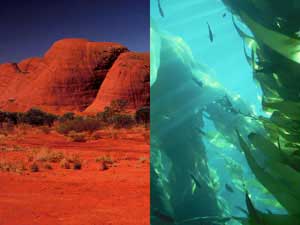The place where an organism occurs is known as its 'habitat'. The habitat is dependent on environmental factors such as temperature, rainfall, location, medium (soil, water, air etc.), vegetation and so on. - Adaptation
Different habitats support different organisms
Adaptation to daily and seasonal changes in habitat - Feeding relationships
Food chains
Food webs Accumulation of toxic materials in a food chain - Competition
Factors affecting populations size
Successful organisms
|
|

Life on Earth has adapted to survive in many different habitats - from the heat of the desert to the depths of the oceans.
|

![[Advert]](../../images/ad/content.gif)

![[Advert]](../../images/ad/content.gif)